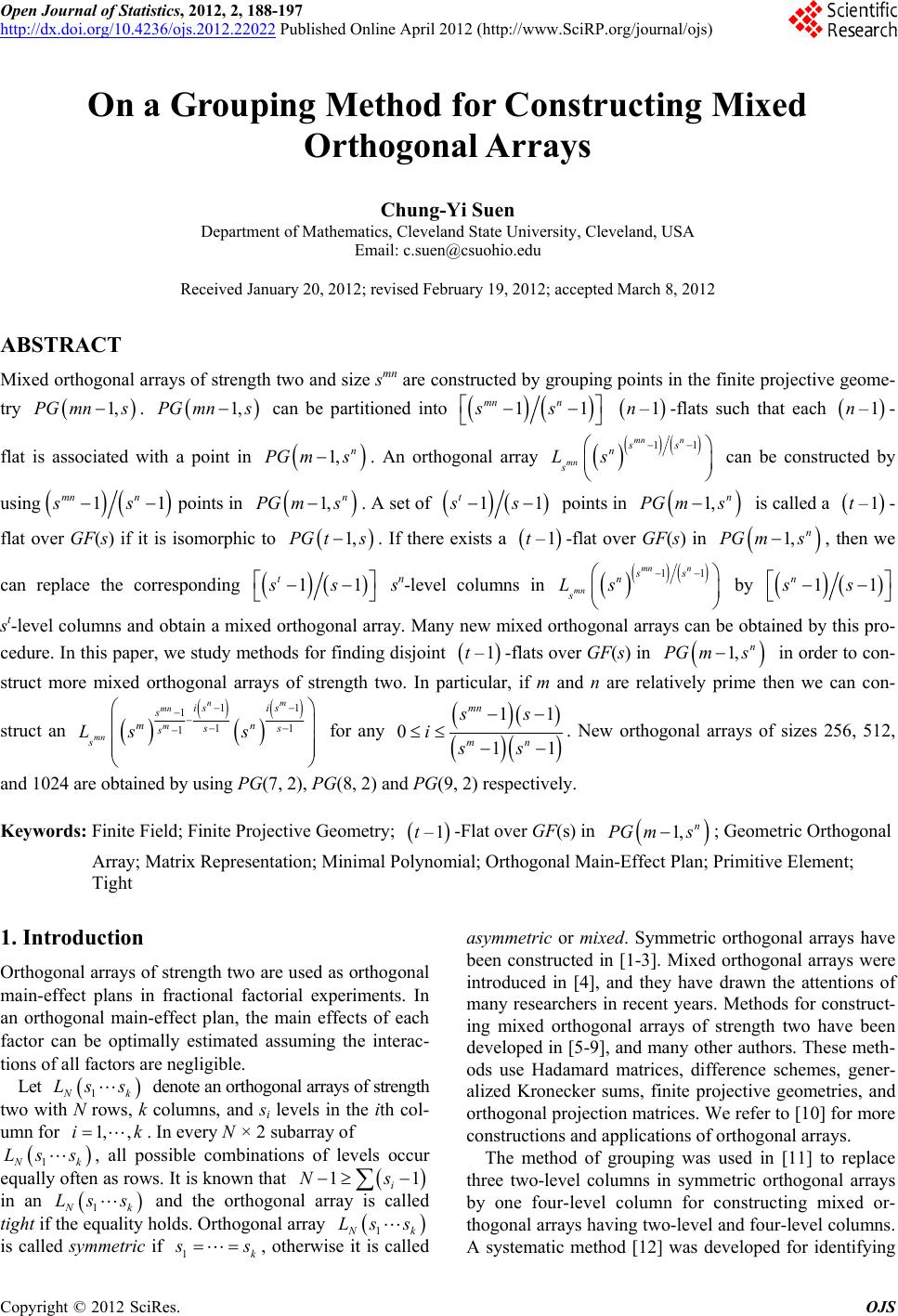 Open Journal of Statistics, 2012, 2, 188-197 http://dx.doi.org/10.4236/ojs.2012.22022 Published Online April 2012 (http://www.SciRP.org/journal/ojs) On a Grouping Method for Constructing Mixed Orthogonal Arrays Chung-Yi Suen Department of Mathematics, Cleveland State University, Cleveland, USA Email: c.suen@csuohio.edu Received January 20, 2012; revised February 19, 2012; accepted March 8, 2012 ABSTRACT Mixed orthogonal arrays of strength two and size smn are constructed by grouping points in the finite projective geome- try . can be partitioned into 1,PG mns 1,PG mns 11 mn n ss –1n-flats such that each –1n- flat is associated with a point in . An orthogonal array 1, n PG ms 11 mn n mn ss n s Ls can be constructed by using 11s mn n s points in 1, n Gm s. A set of 11s t s points in n 1, Gms is called a –1t- flat over GF(s) if it is isomorphic to . If there exists a 1,PG ts –1t-flat over GF(s) in , then we can replace the corresponding 1, n m s PG 11 t ss sn-level columns in 11 mn n mn ss n s Ls by 11ss n st-level columns and obtain a mixed orthogonal array. Many new mixed orthogonal arrays can be obtained by this pro- cedure. In this paper, we study methods for finding disjoint –1t-flats over GF(s) in in order to con- struct more mixed orthogonal arrays of strength two. In particular, if m and n are relatively prime then we can con- struct an 1,PG ms n 11 1is m s 1 is s 1 nm n s 1 mn m mn s s s Ls for any 11 11 n ss ss 0i mn m . New orthogonal arrays of sizes 256, 512, and 1024 are obtained by using PG(7, 2), PG(8, 2) and PG(9, 2) respectively. Keywords: Finite Field; Finite Projective Geometry; –1t-Flat over GF(s) in 1, n PG ms; Geometric Orthogonal Array; Matrix Representation; Minimal Polynomial; Orthogonal Main-Effect Plan; Primitive Element; Tight 1. Introduction Orthogonal arrays of strength two are used as orthogonal main-effect plans in fractional factorial experiments. In an orthogonal main-effect plan, the main effects of each factor can be optimally estimated assuming the interac- tions of all factors are negligible. Let 1 k Ls s 1, ,i denote an orthogonal arrays of strength two with N rows, k columns, and si levels in the ith col- umn for . In every N × 2 subarray of k 1 k Ls s, all possible combinations of levels occur equally often as rows. It is known that 1 i Ns asymmetric or mixed. Symmetric orthogonal arrays have been constructed in [1-3]. Mixed orthogonal arrays were introduced in [4], and they have drawn the attentions of many researchers in recent years. Methods for construct- ing mixed orthogonal arrays of strength two have been developed in [5-9], and many other authors. These meth- ods use Hadamard matrices, difference schemes, gener- alized Kronecker sums, finite projective geometries, and orthogonal projection matrices. We refer to [10] for more constructions and applications of orthogonal arrays. 1 in an The method of grouping was used in [11] to replace three two-level columns in symmetric orthogonal arrays by one four-level column for constructing mixed or- thogonal arrays having two-level and four-level columns. A systematic method [12] was developed for identifying 1 k sLs and the orthogonal array is called tight if the equality holds. Orthogonal array 1 k Ls s is called symmetric if 1k s, otherwise it is called C opyright © 2012 SciRes. OJS 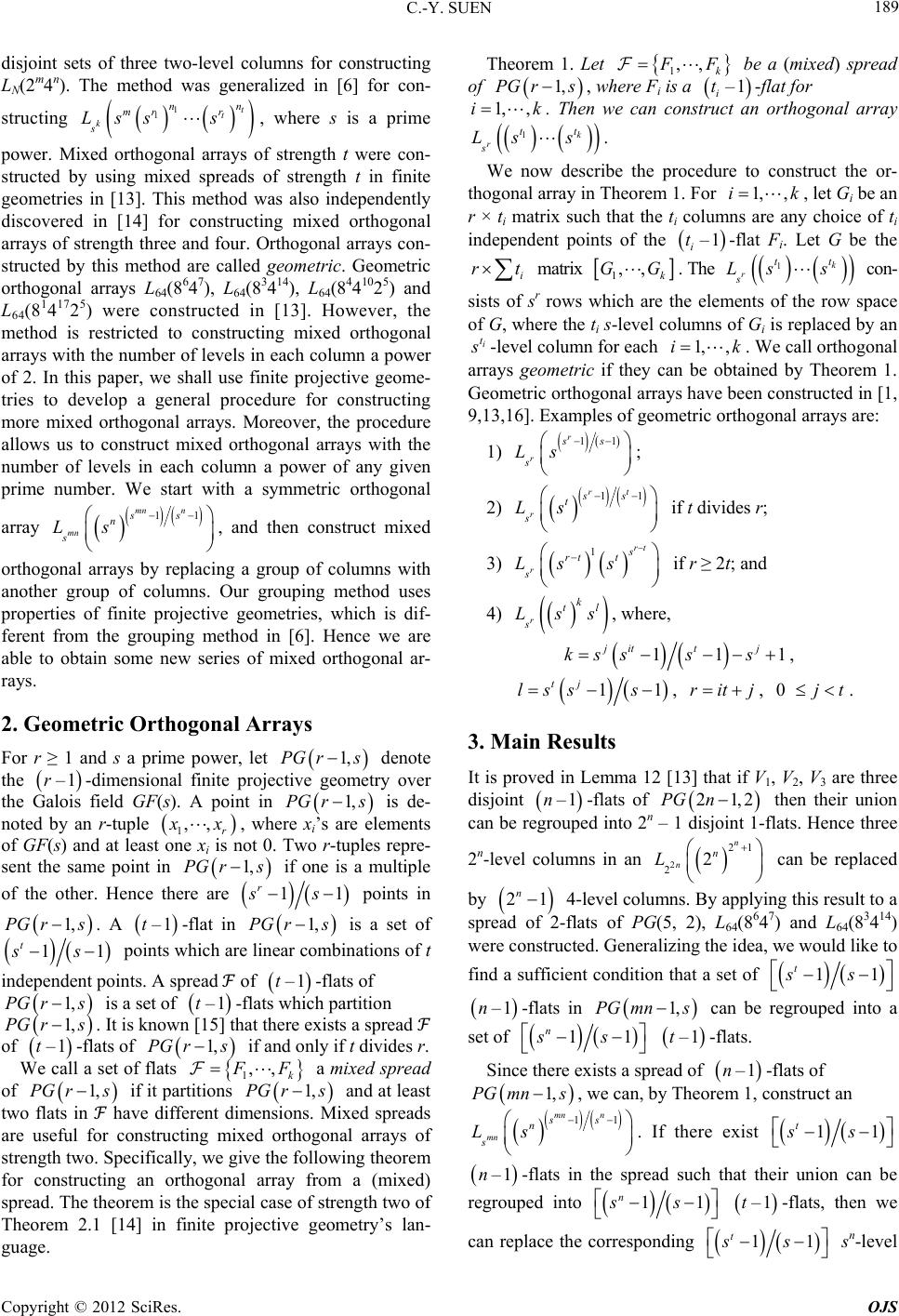 C.-Y. SUEN 189 disjoint sets of three two-level columns for constructing LN(2m4n). The method was generalized in [6] for con- structing , where s is a prime 1 1t t k n nr r m s Lss s power. Mixed orthogonal arrays of strength t were con- structed by using mixed spreads of strength t in finite geometries in [13]. This method was also independently discovered in [14] for constructing mixed orthogonal arrays of strength three and four. Orthogonal arrays con- structed by this method are called geometric. Geometric orthogonal arrays L64(8647), L64(83414), L64(8 441025) and L64(8141725) were constructed in [13]. However, the method is restricted to constructing mixed orthogonal arrays with the number of levels in each column a power of 2. In this paper, we shall use finite projective geome- tries to develop a general procedure for constructing more mixed orthogonal arrays. Moreover, the procedure allows us to construct mixed orthogonal arrays with the number of levels in each column a power of any given prime number. We start with a symmetric orthogonal array 11 mn n mn ss n s Ls , and then construct mixed orthogonal arrays by replacing a group of columns with another group of columns. Our grouping method uses properties of finite projective geometries, which is dif- ferent from the grouping method in [6]. Hence we are able to obtain some new series of mixed orthogonal ar- rays. 2. Geometric Orthogonal Arrays For r ≥ 1 and s a prime power, let denote the -dimensional finite projective geometry over the Galois field GF(s). A point in is de- noted by an r-tuple 1,PG rs 1,PG rs –1r 1,, r x PGr , where xi’s are elements of GF(s) and at least one xi is not 0. Two r-tuples repre- sent the same point in if one is a multiple 1, s of the other. Hence there are 11ss r points in 1,PG rs. A –1t-flat in 1,PG rs is a set of 1 t s1s points whiche linear combinations of t ar independent points. A spread ℱ of -flats of is a set of -flats which partition . It is known [15] that there exists a spread ℱ of -flats of if and only if t divides r. –1t 1,PG rs 1,PG rs –1t –1t 1,r sPG We call a set of flats ,, 1k F a mixed spread of ,s if it partitions and at least two flats in ℱ have different dimensions. Mixed spreads are useful for constructing mixed orthogonal arrays of strength two. Specifically, we give the following theorem for constructing an orthogonal array from a (mixed) spread. The theorem is the special case of strength two of Theorem 2.1 [14] in finite projective geometry’s lan- guage. 1PGr Theorem 1. Let 1,, k F be a (mixed) spread of 1,PG rs 1, ,ik , where Fi is a -flat for –1 i t . Then we can construct an orthogonal array 1k r t t s Ls s . We now describe the procedure to construct the or- thogonal array in Theorem 1. For , let Gi be an r × ti matrix such that the ti columns are any choice of ti independent points of the -flat Fi. Let G be the 1, ,i k t –1 i t i r matrix 1,, k GG . The k r t s Ls s 1 t con- sists of sr rows which are the elements of the row space of G, where the ti s-level columns of Gi is replaced by an i t -level column for each . We call orthogonal arrays geometric if they can be obtained by Theorem 1. Geometric orthogonal arrays have been constructed in [1, 9,13,16]. Examples of geometric orthogonal arrays are: 1, ,ik 1) 11 r r ss s Ls ; 2) 11 rt r ss t s Ls if t divides r; 3) if r ≥ 2t; and 1rt r s rt t s Ls s 4) r k tl s Lss , where, 11 jit t j kssss 1 , 11 tj lss s , , . ritj 0 jt 3. Main Results It is proved in Lemma 12 [13] that if V1, V2, V3 are three disjoint –1n-flats of then their union can be regrouped into 2n – 1 disjoint 1-flats. Hence three 21,2PGn 2n-level columns in an can be replaced 2 21 22 n n n L by 21 n 4-level columns. By applying this result to a spread of 2-flats of PG(5, 2), L64(8647) and L64(83414) were constructed. Generalizing the idea, we would like to find a sufficient condition that a set of 11 t ss –1n-flats in 1,PG mns can be regrouped into a set of 11 n ss –1t-flats. Since there exists a spread of -flats of –1n 1,PG mns, we can, by Theorem 1, construct an 1,PGr s 11 mn n mn ss n s Ls . If there exist 11 t ss –1n-flats in the spread such that their union can be regrouped into 11 n ss -flats, then we can replace the corresponding –1t 11 t ss sn-level Copyright © 2012 SciRes. OJS 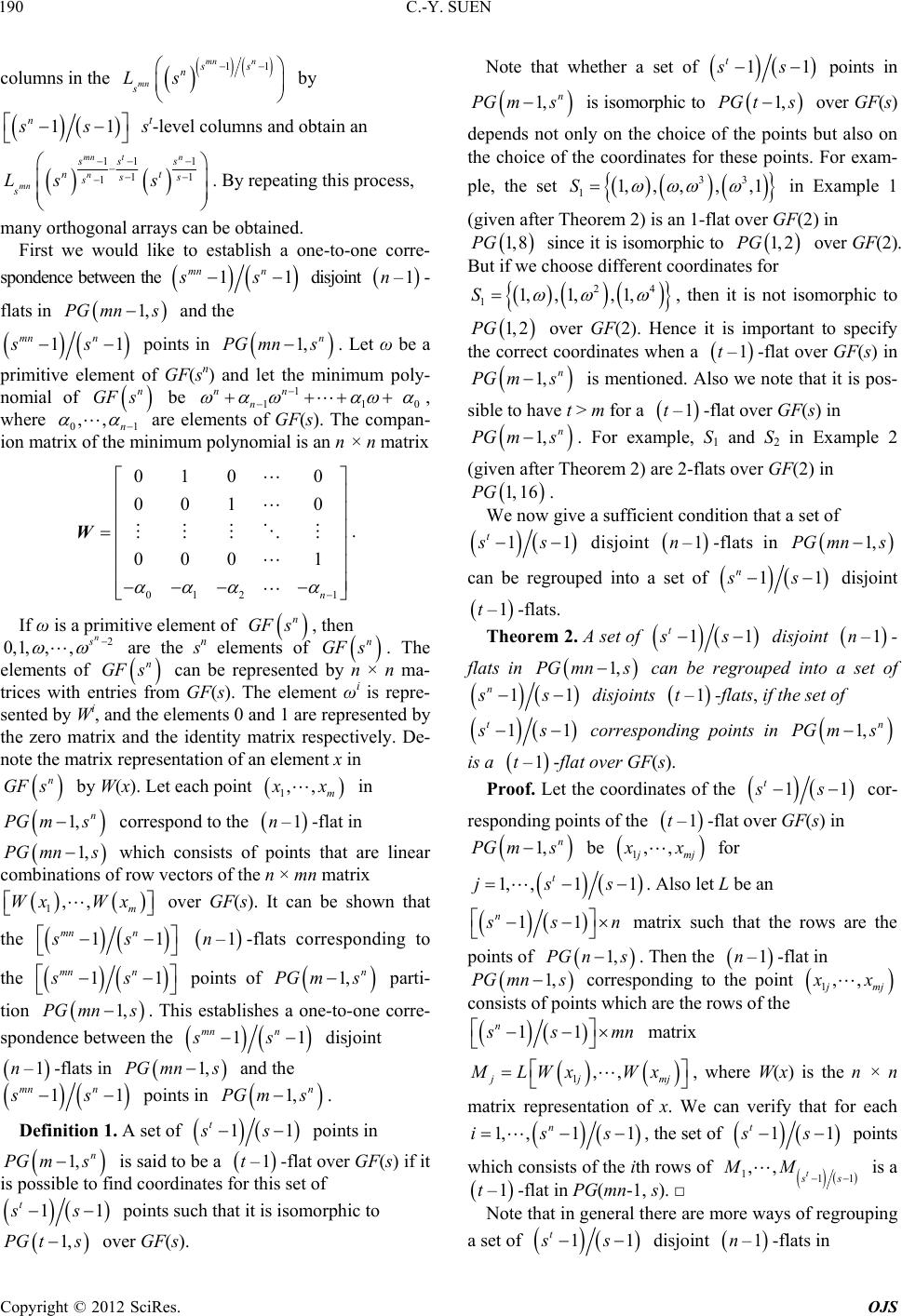 C.-Y. SUEN 190 columns in the 11 mn n mn ss n s Ls by 11 n ss st-level columns and obtain an 111 11 1 mn tn n mn ss s nt ss s s Ls s . By repeating this process, many orthogonal arrays can be obtained. First we would like to establish a one-to-one corre- spondence between the 1 mn n ss1 disjoint –1n- flats in and the 1,PG mns 1 mn n ss1 points in . Let ω be a 1, n PG mns primitive element of GF(sn) and let the minimum poly- nomial of be 0 n GF s1 11 nn n , where 01 ,, n are elements of GF(s). The compan- ion matrix of the minimum polynomial is an n × n matrix 012 1 010 0 001 0 000 1 n W . If ω is a primitive element of , then are the sn elements of . The elements of can be represented by n × n ma- trices with entries from GF(s). The element ωi is repre- sented by Wi, and the elements 0 and 1 are represented by the zero matrix and the identity matrix respectively. De- note the matrix representation of an element x in n GF s 2 0,1, ,,n s GF n GF s n s n GF s by W(x). Let each point 1,, m x –1n in correspond to the -flat in 1,PGm n s 1,PG mns which consists of points that are linear combinations of row vectors of the n × mn matrix 1,, m Wx Wx over GF(s). It can be shown that the 11 mn n ss –1n-flats corresponding to the 11 mn n ss points of parti- 1, n PG ms tion . This establishes a one-to-one corre- 1,PG mns spondence between the 1 mn n ss1 disjoint –1n -flats in and the 1,PG mns 11sPG mn sn points in . 1, n m s Definition 1. A set of 1 t ss1 points in 1, n PG ms is said to be a –1t-flat over GF(s) if it is possible to find coordinates for this set of 1 t ss1 points such that it is isomorphic to 1,PG ts over GF(s). Note that whether a set of 1 t ss1 points in 1, n PG ms is isomorphic to over GF(s) 1,PG ts depends not only on the choice of the points but also on the choice of the coordinates for these points. For exam- ple, the set 33 11,, ,,,1S in Example 1 (given after Theorem 2) is an 1-flat over GF(2) in 1, 8PG since it is isomorphic to 1, 2PG over GF(2). But if we choose different coordinates for 24 11,, 1,, 1,S , then it is not isomorphic to 1, 2PG over GF(2). Hence it is important to specify the correct coordinates when a –1t-flat over GF(s) in 1, n PG ms is mentioned. Also we note that it is pos- sible to have t > m for a –1t-flat over GF(s) in 1, n PG ms. For example, S1 and S2 in Example 2 (given after Theorem 2) are 2-flats over GF(2) in 1, 16PG. We now give a sufficient condition that a set of 1 t ss1 disjoint –1n-flats in 1,PG mns can be regrouped into a set of 11s n s disjoint –1t-flats. Theorem 2. A set of 1 t ss1 disjoint –1n- flats in 1,PG mns can be regrouped into a set of 11s disjoints –1t-flats, if the set of n s 1 t ss1 corresponding points in 1, n PG ms is a –1t-flat over GF(s). Proof. Let the coordinates of the 1 t ss1 cor- responding points of the –1t-flat over GF(s) in 1, n PG ms be ,, 1 mj x for 1, ,1 t js 1s . Also let L be an 11 n sn matrix such that the rows are the points of 1,PG ns. Then the –1n-flat in 1, sPG mn corresponding to the point 1,, mj x consists of points which are the rows of the 11 n sm n matrix 1,, jj M LWxWx mj , where W(x) is the n × n matrix representation of x. We can verify that for each 1, ,11 n iss , the set of 1 t ss1 points which consists of the ith rows of 111 ,, t ss MM is a –1t-flat in PG(mn-1, s). □ Note that in general there are more ways of regrouping a set of 1 t ss1 disjoint -flats in –1n Copyright © 2012 SciRes. OJS 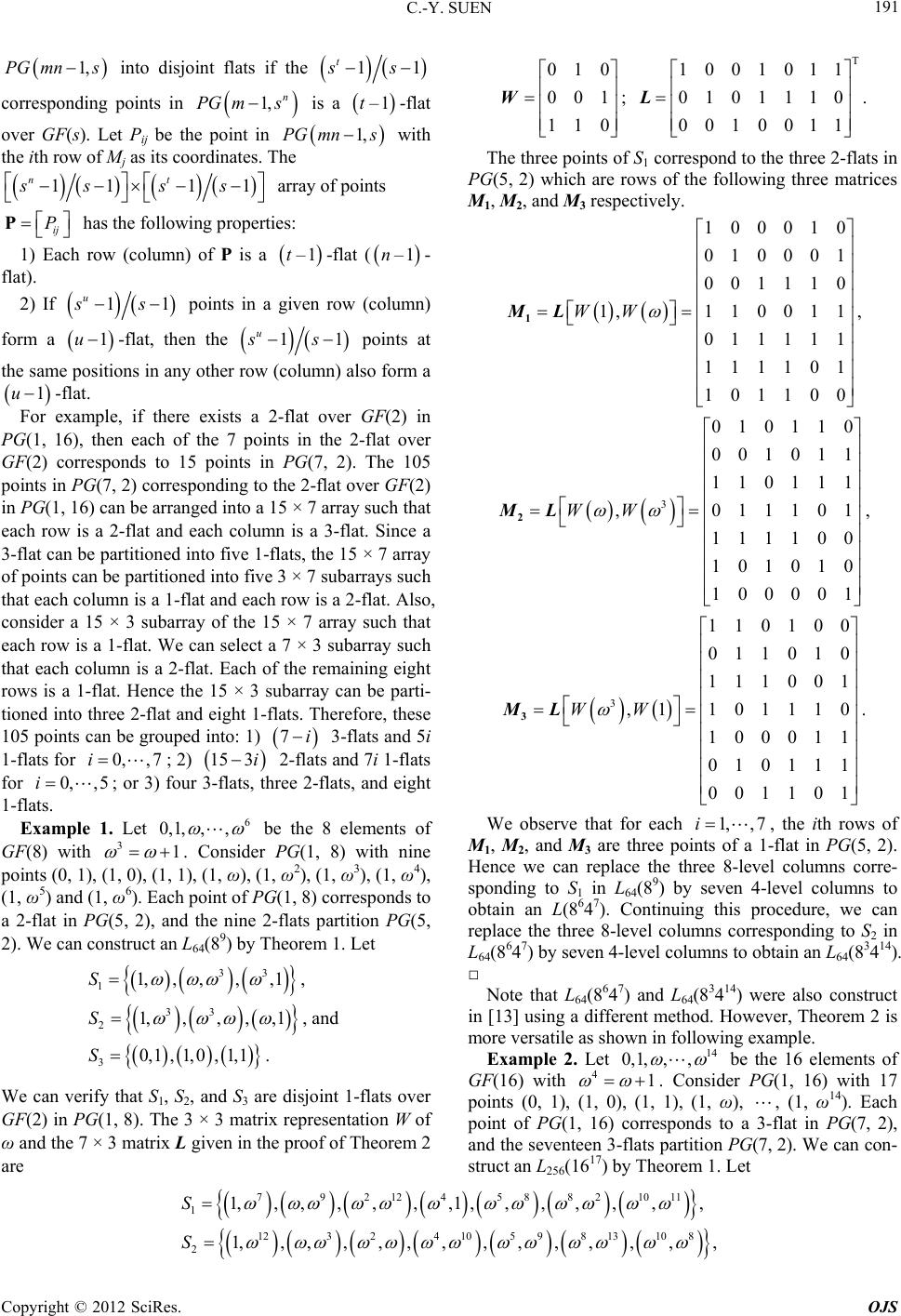 C.-Y. SUEN Copyright © 2012 SciRes. OJS 191 1,PG mns into disjoint flats if the 11 t ss corresponding points in 1, n PG ms is a -flat 010 001 110 W; T 1001011 0101110 0010011 L. –1t over GF(s). Let Pij be the point in with the ith row of Mj as its coordinates. The 1,PG mns The three points of S1 correspond to the three 2-flats in PG(5, 2) which are rows of the following three matrices M1, M2, and M3 respectively. 11 11 nt ss ss array of points has the following properties: ij P P 100010 010001 001110 1, 110011 011111 111101 101100 WW 1 ML 3 010110 001011 110111 ,011101 111100 101010 100001 WW 2 ML 3 110100 011010 111001 ,1 101110 100011 010111 001101 WW 3 ML , , . 1) Each row (column) of P is a -flat ( –1t –1n- flat). 2) If 1 u ss1 points in a given row (column) form a -flat, then the 1u 1 u ss1 points at the same positions in any other row (column) also form a -flat. 1u For example, if there exists a 2-flat over GF(2) in PG(1, 16), then each of the 7 points in the 2-flat over GF(2) corresponds to 15 points in PG(7, 2). The 105 points in PG(7, 2) corresponding to the 2-flat over GF(2) in PG(1, 16) can be arranged into a 15 × 7 array such that each row is a 2-flat and each column is a 3-flat. Since a 3-flat can be partitioned into five 1-flats, the 15 × 7 array of points can be partitioned into five 3 × 7 subarrays such that each column is a 1-flat and each row is a 2-flat. Also, consider a 15 × 3 subarray of the 15 × 7 array such that each row is a 1-flat. We can select a 7 × 3 subarray such that each column is a 2-flat. Each of the remaining eight rows is a 1-flat. Hence the 15 × 3 subarray can be parti- tioned into three 2-flat and eight 1-flats. Therefore, these 105 points can be grouped into: 1) 3-flats and 5i 1-flats for ; 2) 2-flats and 7i 1-flats for ; or 3) four 3-flats, three 2-flats, and eight 1-flats. 7i 0,, 7i ,5 15 3i 0,i We observe that for each , the ith rows of M1, M2, and M3 are three points of a 1-flat in PG(5, 2). Hence we can replace the three 8-level columns corre- sponding to S1 in L64(89) by seven 4-level columns to obtain an L(8647). Continuing this procedure, we can replace the three 8-level columns corresponding to S2 in L64(8647) by seven 4-level columns to obtain an L64(83414). □ 1,, 7i Example 1. Let 6 0,1, ,, 1 be the 8 elements of GF(8) with . Consider PG(1, 8) with nine points (0, 1), (1, 0), (1, 1), (1, ω), (1, ω2), (1, ω3), (1, ω4), (1, ω5) and (1, ω6). Each point of PG(1, 8) corresponds to a 2-flat in PG(5, 2), and the nine 2-flats partition PG(5, 2). We can construct an L64(89) by Theorem 1. Let 3 33 11,,,,, 1S 33 21,,,,,1S , , and 30,1 , 1,0,1,1S. Note that L64(8647) and L64(83414) were also construct in [13] using a different method. However, Theorem 2 is more versatile as shown in following example. Example 2. Let 14 0,1, ,, 1 be the 16 elements of GF(16) with 4 . Consider PG(1, 16) with 17 points (0, 1), (1, 0), (1, 1), (1, ω), , (1, ω14). Each point of PG(1, 16) corresponds to a 3-flat in PG(7, 2), and the seventeen 3-flats partition PG(7, 2). We can con- struct an L256(1617) by Theorem 1. Let We can verify that S1, S2, and S3 are disjoint 1-flats over GF(2) in PG(1, 8). The 3 × 3 matrix representation W of ω and the 7 × 3 matrix L given in the proof of Theorem 2 are 792 1245 88210 11 11,,,,,,,1,,,,, ,S , 123 2410 59813108 21, ,,,,,, ,,,,,,S , 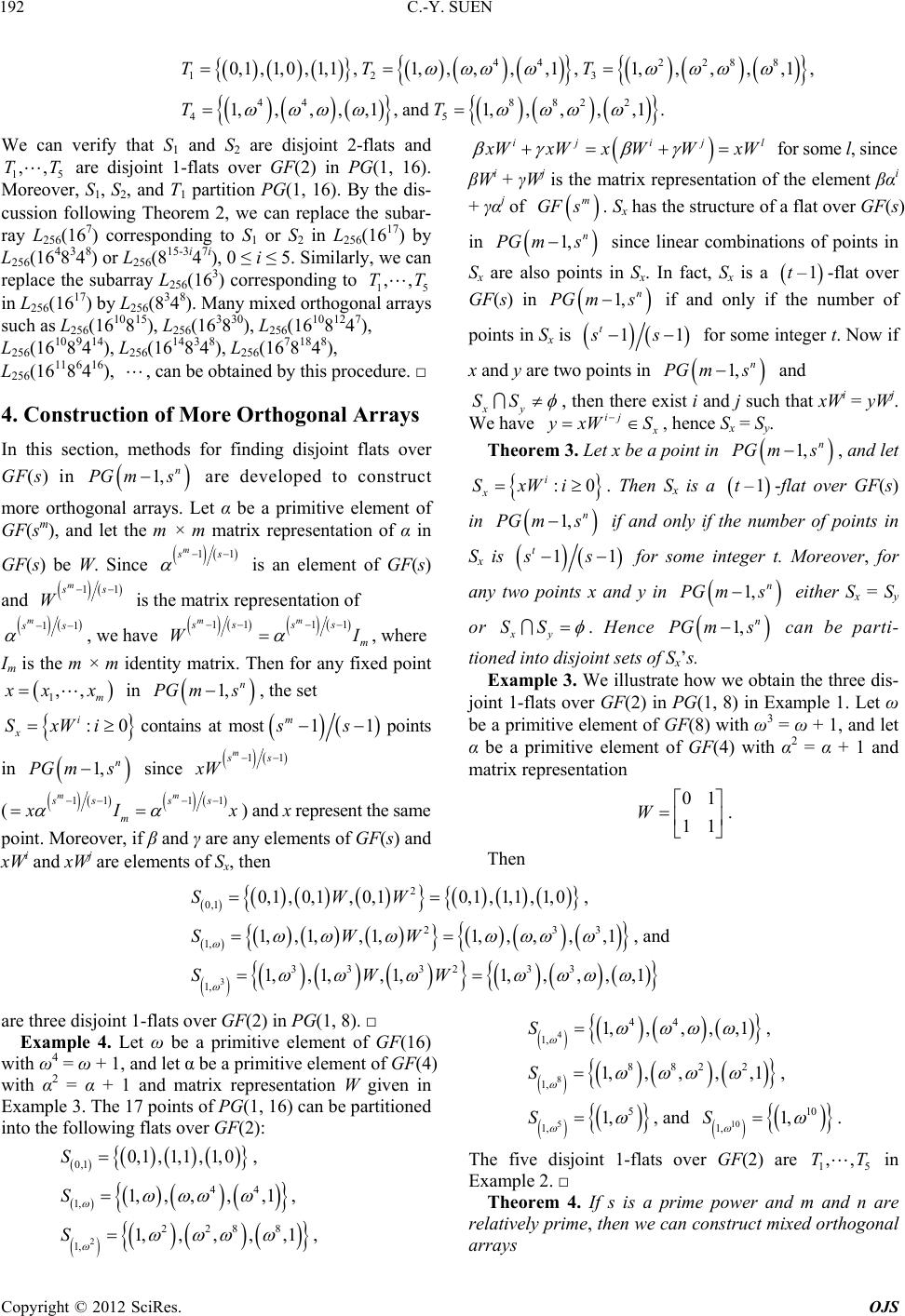 C.-Y. SUEN 192 44 2288 12 3 44 8822 45 0, 1,1,0,1, 1,1,,,,,1,1,,,,,1, 1,, ,,,1,and1,,,, ,1. TT T TT We can verify that S1 and S2 are disjoint 2-flats and are disjoint 1-flats over GF(2) in PG(1, 16). 6 l arrays. Let let the m × 15 Moreover, S1, S2, and T1 partition PG(1, 16). By the dis- following Theorem 2, we can replace the subar- ray L256(167) corresponding to S1 or S2 in L256(1617) by L256(1648348) or L256(815-3i47i), 0 ≤ i ≤ 5. Similarly, we can replace the subarray L256(163) corresponding to 15 ,,TT in L256(1617) by L256(8348). Many mixed orthogonal arrays such as L256(1610815), L256(163830), L256(161081247), L256(161089414), L256(16148348), L256(16781848), L256(16118 416), , can be obtained by this procedur 4. Construction of More Orthogonal Arrays ,,TT cussion e. □ In this section, methods for finding disjoint flats over GF(s) in 1, n PG ms are developed to construct more orthogona a primitive element of α be GF(sm), andm matrix representation of α in GF(s) be W. Since 11 m ss is an element of GF(s) and 11 m ss W is tepresentation of he matrix r 1 m s have 1s , we 1 m ss m is the m × m identity matrix. Then for any fixed point 1 11 m ss m WI , where I 1,, m x x SxWi x in PG 1, n m s ins at mos , the set :0 inta cot 1s since 1s points m in 1, n PG ms 11 xW ( m ss ij ijl WxWxWWxW i j for some l, since βW + γW is the matrix representation of ti + γαj of he element βα m GF s. S has the structure o xf a flat over GF(s) in 1, n Gm since linear combinations of points in Sx are also poiSx. In fact, Sx is a -flat over GF s –1tnts in (s) in 1, n s if and only if the number of PG m points in Sx is 11s t s for some integer t. Now if x and y are two 1, points in n Gm s and xy SS , then there ethat xWi j We have ij xist i and j such = yW . xW S y. , hence Sx = S Theorem 3. Let x be a point in 1, n PG ms, and let :0xWi i x S . Then Sx is a GF(s) –1t-flat over in 1, n Gm s if and only if the points in Sx is number of 11 t ss for some integer t. Moreover, for any two n 1, n PG ms either Sx = Sy or xy SS points x and y i . Hence 1, n Gm s can be parti- Ee illustrate how we obtain the three dis- tioned into disjoint sets of Sx’s. xample 3. W , 8) in Example 1. Let ω be joint 1-flats over GF(2) in PG (1 a primitive element of GF(8) with ω3 = ω + 1, and let α be a primitive element of GF(4) with α2 = α + 1 and matrix representation 01 W 11ss m 11ss mm Ix rep xW then ) and xresent the same point. Moreover, if β and γ are any elements of GF(s) and i and xWj are elements of Sx, 11 . Then 2 0,1 0,1 ,0,1,0,1SWW, 0,1, 0 , 1,1 , 1 23 1, 1,, 1,, 1,1,,,,SWW 3 ,1 , and 3 33 323 1, 1, ,1,,1,1, ,,SWW 3 , , 1 are three disjoint 1-flats over GF(2) in PG(1, 8). □ Example 4. Let ω be a primitive element of GF(16) GF(4) with ω4 = ω + 1, and let α be a primitive element of with α2 = α + 1 and matrix representation W given in Example 3. The 17 points of PG(1, 16) can be partitioned into the following flats over GF(2): 0,10,1,1,1,1,0S, 44 1, 1,, ,,S , 1, 2 228 1, 1,,,,S 8 , ,1 4 44 1, 1,,,,,1S , 8 8822 1, 1,, ,,,1S , 5 5 1, 1,S , and 10 1, S ve disjoint 1-flats over GF(2 ple 2. □ Theorem 4. If s is a prime power a relatively prime, then we can construct 10 e nd m an d orth 1, . The fi in Exam d n are ogonal arrays ) ar mixe 15 ,,TT Copyright © 2012 SciRes. OJS 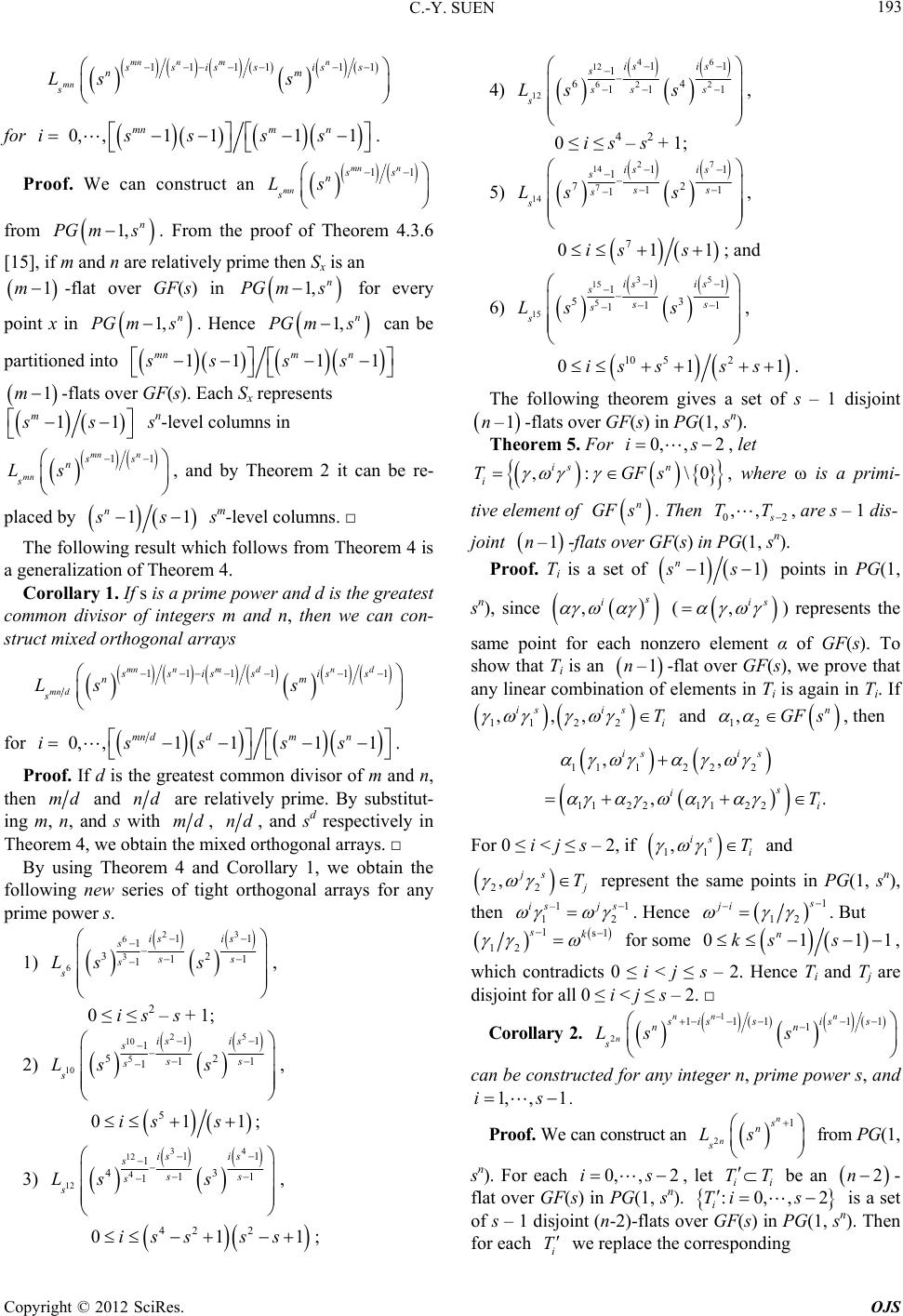 C.-Y. SUEN 193 1 1 mn nn mn sss iss nm s Ls s 1 111 m is for 0,,i 1 111 mnm n ssss . Proof. We can construct an 11 mn n mn ss n Ls s from . From the proof of Theorem.6 [15], if m and n are relatively prime then S is an -flat over GF(s) in 1, n PG ms 4.3 x 1, n m1 Gm s 1,PG ms foevery . Hence can be r point x in pa 1, n PG ms n rtitioned into 11 mn ss 1mF(s). Each Sx represents 1 m n ss 1 -flats over G 11 m ss sn-level columns in 11 mn n mn ss n s placed by Ls , and by Theorem 2 it can be re- 11 n ss sm-level columns. □ The eorem 4 is a general Corollary 1. If d is the greatest common divisor of integers m and n, then we can con- struct mixed orthogon following result which follows from Th ization of Theorem 4. s is a prime power and al arrays 11 1 mn nd ss s n s 11 1 m dn mn d issis m s L s for 0,,11 mn dd iss 1 1ss . Proof. If d is the greatest common divisor of m and n, then m n md and nd are relativ ing m, n, and s with ely prime. By substitut- md, nd, xed ort and sd respectively in Theorem 4, we obtain the mihogonal arrays. □ By using Theorem 4 and Corollary 1, we obtain the following new series of tight orthogonal arrays for any e power s. prim 1) 23 6 3 11 1 32 11 is is s s s ss s , 0 ≤ i ≤ s2 – s + 1; 61s L 2) 25 10 5 10 11 1 52 11 1 isis s ss s s Ls s , 5 01is s ; 1 3) 34 12 12 11 1 1 is is s s s L , 4 43 1 1s s s s 422 01iss ss ; 4) 46 12 62 2 12 11 1 64 11 1 is is s ss s s Lss , 0 ≤ i ≤ s4 – s2 + 1; 5) 27 14 7 14 11 1 72 11 1 isis s ss s s Ls s , 7 01iss1 ; and 6) 35 15 5 15 11 1 53 11 1 is is s ss s s Ls s , 10 52 01is s1ss . The following theorem gives a set of s – 1 disjoint –1 n-flats over GF(s) in PG(1, sn). Theorem 5. For 0, ,2 is , let ,: \0 is n i TGFs tive element of , where ω is a primi- n GFs. Then 02 ,, TT , are s – 1 dis- joint –1n- Proof. T flats over GF(s) in PG ). i is a set of (1, sn 11 n ss points in PG(1, sn), since , i ( ,is ) represents the sa sh me point for each nonzero element α of GF(s). To ow that Ti is an –1n-flat over GF( binati ts in T s), we prove that any linear comelemen is again in T. If on of i i 112 2 ,,, isis i T and 12 ,n GF s , then 112 2 ,, isi s s i 11 22 ,. i T 1112 22 For 0 ≤ i < j ≤ s – 2, if 1 is i T 1 ,d an 22 ,js T represent the same points in PG(1, sn), then –1 1 12 is js . Hence 1 12 ji . But 1s1 sk 1 12 for so me 0 11 , 1 n ks s which contradicts 0 ≤ i < j ≤ s – 2. Hence Ti and Tj are disjoint for all 0 ≤ i < j ≤ s – 2. □ Corollary 2. 1 2 111 1 n s1 1 nn n sis sis nn s Ls s any integer n, wer s, and can be constructed for prime po 1, ,1is . Pro truct an om PG(1,of. We can cons fr sn). For each 1 n s n 2n s Ls 0,is, 2 , let be an ii TT 2n - flat over GF(s) in PG(1, sn). :0,,2 i Ti s is a set of s – 1 disjoint (n-2)-flats over GF(s) in PG(1, sn). Then for each Ti we replace the corresponding Copyright © 2012 SciRes. OJS 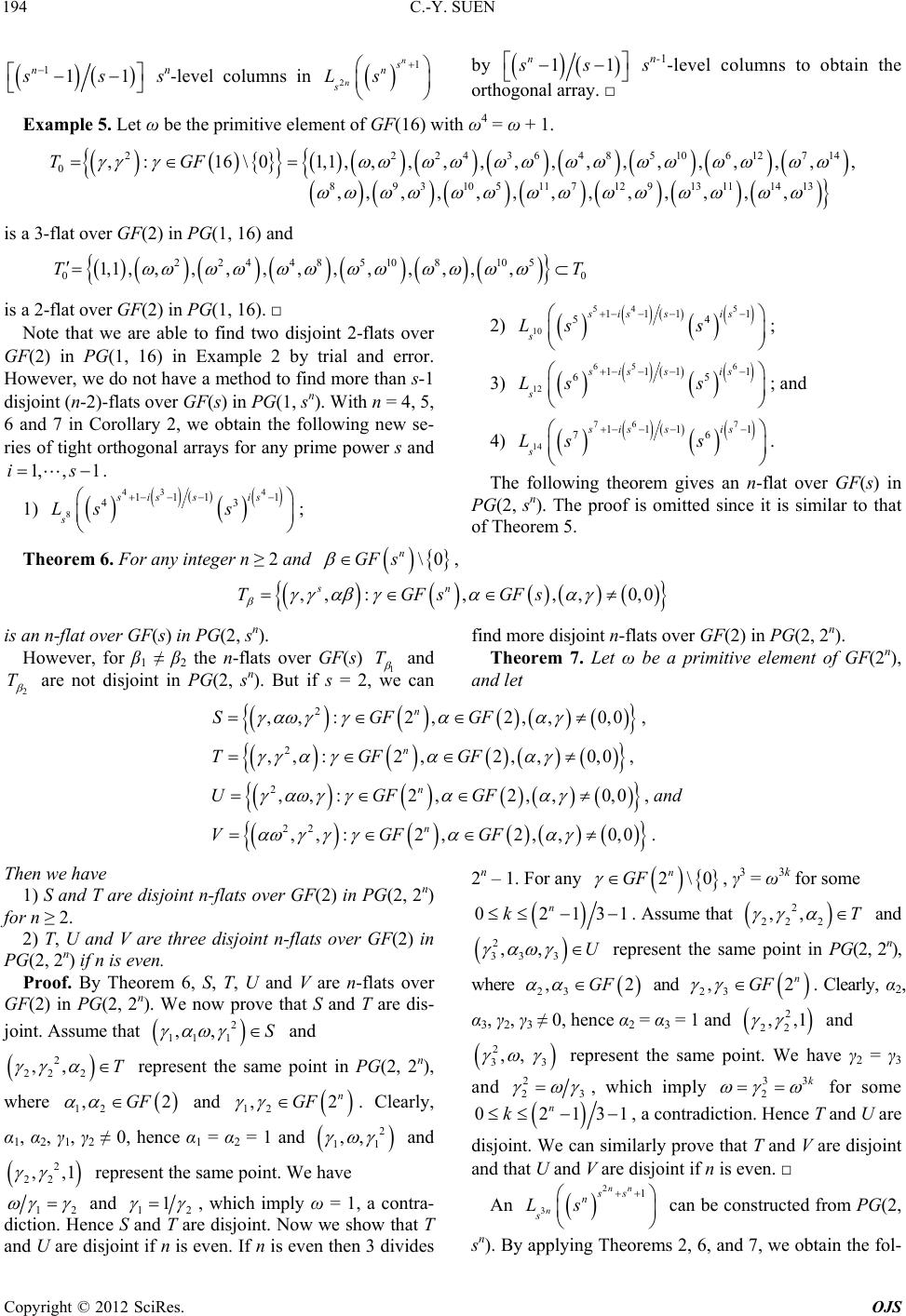 C.-Y. SUEN Copyright © 2012 SciRes. OJS 194 111 n ss sn-level columns in by 11 n ss sn-1-level columns to obtain the 2 1 n n s n s Ls orthogonal array. □ ith ω4 = ω + 1. Example 5. Let ω be the primitive element of GF(16) w 22 24 36 48510 612 714 810511 712913 1114 13 ,:16\01,1,,,,,,,,,,,,,,, ,,,,,,,,,,,,, TGF 0 9 3 is a 3-flat over GF(2) in PG(1 , 16) and 224485108 0 1,1,,,,,,,,,,T 105 0 ,, T is a 2-flat over GF(2) Note that we arnt 2-flats ove FPG 1, 16n Example 2 by trial andror. H disjoint (n-2)-flats over GF(s) in PG(1, sn). With n = 4, 5, 6 and 7 in Corollary 2, we obtain the following new se- ries of tight orthogonal arrays for any prime power s and 1) in PG(1, 16). □ e able to find two disjoir 54 5 10 111 1 54 sis sis s Ls s ; G(2) in () i er owever, we do not have a method to find more than s-1 1, , 1 is. 8 43 s Ls s ; 2) 3) 65 6 12 1111 65 sis sis s L s s ; and 4) 76 7 14 111 1 76 sis sis s Ls s . 43 4 1111sis sis The following theorem gives an n-flat over GF(s) in PG(2, sn). The proof is omitted since it is similar to that of Theorem 5. nd \0 n GF s Theorem 6. For any integer n ≥ 2 a, ,,: s TGFs is an n-flat over GF(s) in PG(2, sn). However, for β1 ≠ β2 the n-flats over GF(s) 1 T ,,, 0,0 n GFs fin ore disjoint n-flats over GF(2) in 2n). Theorem 7. Let ω be a primitive element of GF(2n), ant d mPG(2, and 2 T are not disjoint in PG(2, sn). But if s = 2, we can d le 2 ,, :2,2,,0,0 n SGFGF , 2 ,, :2, n TGFG 2,, 0,0F , 2:2,2,, 0,0 n GFF ,,UG , and 22 ,,:2,2,, 0,0 n VGFGF . G(n fo 2 PG(2, 2n) if n is even. Proof. By Theorem 6, S, T, U and V are n-flats over GF(2) in PG(2, 2n). We now prove that S and T are dis- joint. Assume that and represent the same point in PG(2, 2n), and . Clearly, 2n – 1. For any 2\0 n GF , γ3 = ω3k for some Then we have 1) S and T are disjoint n-flats over GF(2) in P2, 2) r n ≥ 2. ) T, U and V are three disjoint n-flats over GF(2) in 02131 n k . Assume that 2 22 2 ,, T and 2 33 3 ,, U represent the sam 2n), where e point in PG(2, 23 ,2GF γ3 ≠ 0, hence α2 23 ,2 n GF 1 and 2 22 ,,1 and = . Clearly, α2, α3, γ2, α3 = and 2 111 ,, S 2 33 ,, representme point. We have γ2 = γ3 and the sa 2 22 2 ,, T where 12 1 ,2GF 12 ,2 n GF α, α2, γ1, γ2 ≠ 0, hence α1 = α2 = 1 and 2 11 ,, and 2 ,,1 22 represent the same point. We have 12 and 1 12 , which imply ω = 1, a contra- diction. Hence S and T are disjoint. Now we show that T U are disjoint if n is even. If n is even then 3 divides and 2 23 , whichply 33 2 k im for some 02131 n k , a contradiction. Hence T and U are disjoint. We can sim T and V ilarly prove thatare disjoint and that U and V are disjoint if n is even. □ onstructed fr sn). By applying Theorems 2, 6, and 7, we obtain the fol- An 21 nn ss can be com PG(2, 3n n s Ls  C.-Y. SUEN 195 lowing orthogonal arrays. Corollary 3. For any prime power s, we can construct 1) 2 11 1 nnn ss ssss 3n s Ls 2) ω3 = ω + 1. Let 1 nn s , 2n; Example 6. Let ω be the primitive element of GF(8) with 1 2 1 2 n n L 2 2 2323 2 nn n , 2n; and 3 2n 3) 24 6 323252 4 21 2 222 nnn n nn L , 1n 4 5365 , ,0,,,0,,, 2 243 4 1,1,0, ,,0,0,0,0,0,1, 1,1,1,,,1,,,1,,,1,, 26 5365 ,1,,,1,, ,1 and 2436 ,, ,0,,S 224364 5365 22 43 65 36 5 1,0,1,,0,, ,0,,,0,, ,0,,,0,, ,0,,0,,0, ,,,,,,,,,,,, T be two disjo e constru ). We can rray L(8 o S or T by an to The following two examples are obtained by applying Theorems 3 and 5 and by trial and error. Example 7. Let ω be the primitive element of GF(8) with ω3 = ω + 1. Let 4 , 1,,1,,,,, int 3-flats over GF(2) in PG(2,8). An L512(873) can bcted from PG(2,8replace the ba 15) corresponding t L(167) su 512 512 obtain L512(167858) and L512(1614843). □ 223 11,,,0,1,,1,, 0A , 2446 11,,,0,1,,1,,0B , 45 11,,,0,1, ,1,,0C , and W be the 3 × 3 matrix defined in E 1. For xample 2,, 7i plying each , let Ai (or Bi, Ci) be the set obtained by multi- element in Ai (or Bi, Ci) by W. For Example, 2232622 21,,,0,1,,1,, 0,,,,,1,0,1,AWWW 3 . can be verified thatIt 17 ,, A, , G(2, 8) by an L ment of GF(32) w 1) , 1717 and 1, 0, 0,0,1, 0,1,1, 0 are 22 disjoint 1-flats over GF(2) in PG(2, 8). An L512(873) can be constructed from PG(2, 8). We can replace the subarray L512(83) corre- sponding to each 1-flat over GF(2) in P ,,BB,,,CC 512(47) to obtain L512(873-3i47i) for 1,,22i. □ Example 8. Let ω be the primitive ele ith ω5 = ω2 + 1. An L1024(3233) can be constructed from G(1, 32). P 11, 0,0,1,1,1A 18 , , 18 21,,A ,1 , 2255 , ,1 , 31,, ,A 44 1010 41,, ,,,1A , 5522 51,, ,,,1A , 88 2020 61,,,,,1A , 991616 71,, ,,,1A , 1010 44 1,,,, ,1A 8, 1414 1313 91,,,, ,1A , 1616 99, and 10 1,,,,,1A 1919 11 11 1,,,, ,1A n disjoint 1-flats over GF(2) in place the subarray L1024(323) corres GF(2) in the L1024(3233) by L1024(3233-3i163i416i) for 1,,i 11 are eleve(1, 32). We can reding to each 1-flat over L1024(163416) to obtain PG po a 1 n n 1. 2) 212318 262 11,, ,,,,,B 255192811 12 ,,1 ,,,, , 2581872 145219411 29 21,,,,, ,,,,,, ,,B , 25 18216515 1924 119 31,,,,1 ,,,,,,,,B , and , 621817 219 5201915112 41,, ,,,,,,,,,,,B 5 G(1,32) 2 are four disjoint 2-flats over GF(2) in P. We can replace the subarray L1024(327) corresponding to each 2- flat over GF(2) in the L1024(3233) by an L1024(167816) or an L1024(831) to obtain L1024(3233-7i-7j167i816i+31j) for 1 ≤ i + j ≤ 4. Copyright © 2012 SciRes. OJS 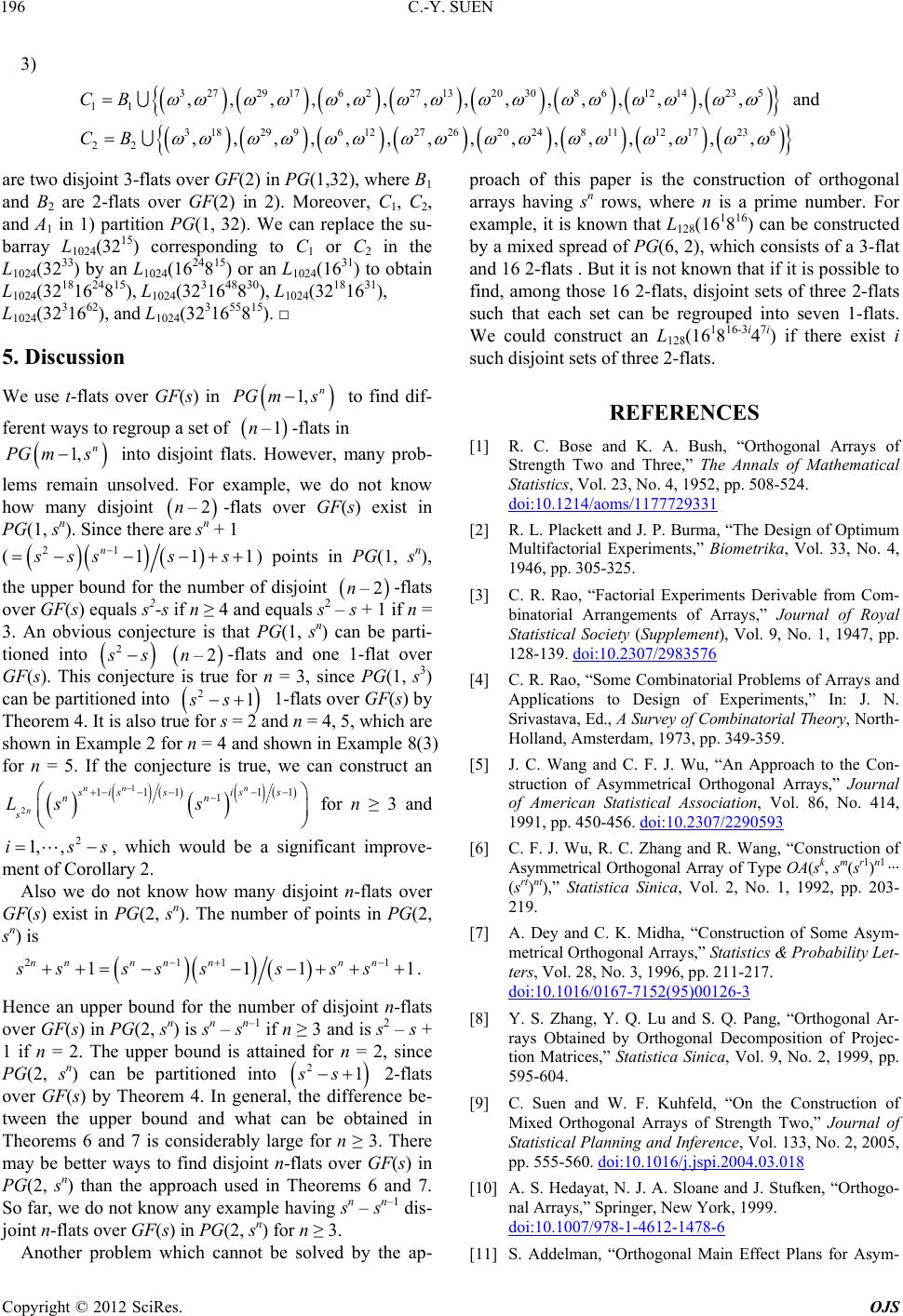 C.-Y. SUEN 196 3) 32729176227132030861214235 11 ,,,,,,,,,,,,,,,CB and 3182996 12272620248 1112 17236 22 ,,,,,,,,,,,,,,CB , are two disjoint 3-flats over GF(2) in PG(1,32), where B1 and B2 are 2-flats over GF(2) in 2). Moreover, C1, C2, and A1 in 1) partition PG (1, 32). We can replace the su- barray L1024(3215) corresponding to C1 or C2 in the 1024(3233) by an L1024(1624815) or an L1024(1631) to obtain 5. Discussion We use t-flats over GF(s) in L L1024(32181624815), L1024(3231648830), L1024(32181631), L1024(3231662), and L1024(3231655815). □ 1, n Gm s to find dif- erent ways to regroup a set of -flats in f –1n 1, n Gm s into disjoint flats. However, many prob- lems remain unsolved. For example, we do not know how many disjoint –2n-flats over GF(s) exist in PG(1, sn). Since there are sn + 1 ( 21 111 n sss s ) points in PG(1, sn), the upper bound for the number of disjoint –2n-fl over GF(s) equals s2-s if n ≥ 4 nd equa ats als s2f n = njecture is that PG(1, sni- – s + 1 i ) can be part3. An obvious co tioned into 2 s –2n ss -flats and over r n = 3, si 1- nd h are shown in Exam one 1-flat n hic GF(s). This conjecture is true foce PG(1, s3) 2rGF(s) by can be partitioned into flats ove Theorem 4. It is also true for s = n = 4, 5, w 1 2 a ple 2 for n = 4 and shown in Example 8(3) for n = 5. If the conjecture is true, we can construct an 1 2 11 11 nnn n sissis s nn s Ls s for n ≥ 3 and 1 1 s, which would be 2 1,, si a significant improve- ment of Corollary 2. Also we do not know how many disjoint n-flats over GF(s) exist in PG(2, sn). The number of points in PG(2, sn) is 211 1 111 nnnn nnn ss ssss . Hence an upper bound for the number of disjoint n-flats over GF(s) in PG(2, sn) is sn – sn–1 if n ≥ 3 and is s2 – s + 1 if n = 2. The upper bound is attained for n = 2, since n 1ss PG(2, s) can be partitioned into 2-flats over GF(s) by Theorem 4. In general tween the upp ver GF(s) in PG(2, sn) for n ≥ 3. Another problem which cannot be solved by the ap- proach of this paper is the cuction of orthogonal arrays having sn rows, wher a prime number. For example, it is known that L128 16) can be constructed by a mixed spread of PG(6, 2), wh consists of a 3-flat and 16 2-flats . But it is not known that if it is possible to could constructL128(16 83i47i) if there exist i such disjoint sets of three 2-flats. REFERENCES [1] R. C. Bose and K. A. Bush, “Orthogonal Arrays of Strength Two and Three,” The Annals of Mathematica Statistics, Vol. 23, No. 4, 1952, pp. 508-524. 21ss , th e difference be- er bound and what can be obtained in Theorems 6 and 7 is considerably large for n ≥ 3. There may be better ways to find disjoint n-flats over GF(s) in PG(2, sn) than the approach used in Theorems 6 and 7. So far, we do not know any example having sn – sn–1 dis- joint n-flats o onstr e n is (1618 hic find, among those 16 2-flats, disjoint sets of three 2-flats uch that each set can be regrouped into seven 1-flats. e an 116- s W l doi:10.1214/aoms/1177729331 [2] R. L. Plackett and J. P. Burma, “The Design of Optimum Multifactorial Experiments,” Biometrika, Vol. 33, No. 4, 1946, pp. 305-325. [3] C. R. Rao, “Factorial Experiments Derivable from Com- binatorial Arrangements of Arrays,” Journal of Royal Statistical Society (Supplement), Vol. 9, No. 1, 1947, pp. 128-139. doi:10.2307/2983576 [4] C. R. Rao, “Some Combinatorial Problems of Arrays and Applications to Design of Experiments,” In: J. N. Srivastava, Ed., A Survey of Combinatorial Theory, North- Holland, Amsterdam, 1973, pp. 349-359. [5] J. C. Wang and C. F. J. Wu, “An Approach to the Con- struction of Asymmetrical Orthogonal Arrays,” Journal of American Statistical Association, Vol. 86, No. 414, 1991, pp. 450-456. doi:10.2307/2290593 [6] C. F. J. Wu, R. C. Zhang and R. Wang, “Construction of Asymmetrical Orthogonal Array of Type OA(sk, sm(sr1)n1 ··· (srt)nt),” Statistica Sinica, Vol. 2, No. 1, 1992, pp. 203- 219. [7] A. Dey and C. K. Midha, “Construction of Some Asym- metrical Orthogonal Arrays,” Static & Probability Let- ters, Vol. 28, No. 3, 1996, pp. 21 tis s 1-217. doi:10.1016/0167-7152(95)00126-3 [8] Y. S. Zhang, g, “Orthogonal Ar- struction of Y. Q. Lu and S. Q. Pan rays Obtained by Orthogonal Decomposition of Projec- tion Matrices,” Statistica Sinica, Vol. 9, No. 2, 1999, pp. 595-604. [9] C. Suen and W. F. Kuhfeld, “On the Con Mixed Orthogonal Arrays of Strength Two,” Journal of Statistical Planning and Inference, Vol. 133, No. 2, 2005, pp. 555-560. doi:10.1016/j.jspi.2004.03.018 [10] A. S. Hedayat, N. J. A. Sloane and J. Stufken, “Orthogo- nal Arrays,” Springer, New York, 1999. doi:10.1007/978-1-4612-1478-6 [11] S. Addelman, “Orthogonal Main Effect Plans for Asym- Copyright © 2012 SciRes. OJS  C.-Y. SUEN 197 metrical Factorial Experiments,” Technometrics, Vol. 4, No. 1, 1962, pp. 21-46. doi:10.2307/1266170 [12] C. F. J. Wu, “Construction of 2m4n Deigns via a Grouping Scheme,” Annals of Statistics, Vol. 17, No. 4, 1989, pp. 1880-1885. doi:10.1214/aos/1176347399 [13] E. M. Rains, N. J. A. Sloane and J. Stufken, “The Lattice of N-Run Orthogonal Arrays,” Journal of Statistical Plan- ning and Inference, Vol. 102, No. 2, 2002, pp. 477-500. doi:10.1016/S0378-3758(01)00119-7 [14] C. Suen, A. Das and A. Dey, “On the Construction of Asymmetric Orthogonal Arrays,” Statist 11, No. 1, 2001, pp. 241-260. ica Sinica, Vol. metric Or- 00165-9 [15] J. W. P. Hirschefld, “Projective Geometries over Finite Fields,” Oxford University Press, Oxford, 1979. [16] C. Suen and A. Dey, “Construction of Asym thogonal Arrays through Finite Geometries,” Journal of Statistical Planning and Inference, Vol. 115, No. 2, 2003, pp. 623-635. doi:10.1016/S0378-3758(02) Copyright © 2012 SciRes. OJS
|